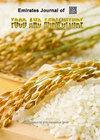优化泡菜产乳酸菌分离物的培养条件并评估其细胞外 GABA 生产能力
IF 0.7
4区 农林科学
Q3 AGRONOMY
引用次数: 0
摘要
本研究的目的是以一种产γ-氨基丁酸(GABA)能力强的乳酸菌为参考菌株,优化培养基和培养条件,筛选和鉴定泡菜中产GABA的乳酸菌分离物,并确定它们的细胞外GABA生产能力。采用薄层色谱法筛选产 GABA 的细菌分离物,并采用高效液相色谱法评估细菌的 GABA 产能。利用物种特异性聚合酶链反应分析鉴定了产 GABA 的细菌分离物。研究发现,最佳培养基和培养条件是改良的 Man-Rogosa-Sharpe (MRS) 肉汤(初始 pH 值为 6.5),其中含有 4% 蔗糖、5% 谷氨酸和 1% 酵母提取物,培养温度为 37°C,培养时间为 5 天。在优化的培养条件下培养后,筛选出 217 种泡菜细菌分离物,以评估它们各自产生 GABA 的能力。通过对 217 株泡菜细菌分离物的筛选,发现了 24 株能产生 GABA 的乳酸菌分离物(占 11%):植物乳杆菌(17 株)、布莱维斯乳杆菌(6 株)和中肠亮杆菌(1 株),这表明只有一小部分菌株能在培养液中产生 GABA。本研究中鉴定出的细菌菌株的胞外 GABA 产出能力即使在同一物种中也各不相同,17 株产 GABA 的植物酵母分离菌株的产 GABA 能力从 5.8 到 101.7 毫摩尔不等,6 株产 GABA 的酿酒酵母分离菌株的产 GABA 能力从 8.5 到 88.6 毫摩尔不等。总之,在 24 个泡菜 GABA 产菌分离物中发现了 3 个物种,包括一个稀有物种(L. mesenteroides)和两个最主要的物种(L. brevis 和 L. plantarum)。 关键词布莱维斯乳酸菌;植物乳酸菌;中肠亮杆菌;优化;γ-氨基丁酸(GABA)本文章由计算机程序翻译,如有差异,请以英文原文为准。
Optimization of culture conditions for and assessment of kimchi-originated lactic acid bacterial isolates toward their extracellular GABA-producing ability
The objectives of this study were to optimize the medium and culture conditions using a strong γ-aminobutyric acid (GABA) producer as a reference lactic acid bacterial strain, to screen and identify GABA-producing lactic acid bacterial isolates from kimchi, and to determine their extracellular GABA-producing abilities. Thin-layer chromatography was used to screen GABA-producing bacterial isolates and high-performance liquid chromatography was used to evaluate the bacterial GABA production abilities. Species-specific polymerase chain reaction analyses were used to identify GABA-producing bacterial isolates. The optimal medium and culture conditions were found to be the modified Man–Rogosa–Sharpe (MRS) broth (with an initial pH of 6.5) containing 4% sucrose, 5% glutamate, and 1% yeast extract at 37°C for 5 days. After incubation under the optimized culture conditions, 217 kimchi bacterial isolates were screened to evaluate their respective GABA-producing abilities. Screening the 217 kimchi bacterial isolates identified 24 GABA-producing lactic acid bacterial isolates (11%): Lactobacillus plantarum (17), Lactobacillus brevis (six), and Leuconostoc mesenteroides (one), indicating that only a small proportion of the strains produce GABA in the culture broth. The extracellular GABA-producing abilities of the bacterial strains identified in this study varied even within the same species, ranging from 5.8 to 101.7 mM among the 17 GABA-producing L. plantarum isolates and from 8.5 to 88.6 mM among the six GABA-producing L. brevis isolates. In summary, three species of the 24 kimchi GABA-producing bacterial isolates were identified, including one rare species (L. mesenteroides) and the two most dominant species (L. brevis and L. plantarum). Keywords: Lactobacillus brevis; Lactobacillus plantarum; Leuconostoc mesenteroides; Optimization; γ-aminobutyric acid (GABA)
求助全文
通过发布文献求助,成功后即可免费获取论文全文。
去求助
来源期刊

Emirates Journal of Food and Agriculture
AGRONOMYFOOD SCIENCE & TECHNOLOGY&nb-FOOD SCIENCE & TECHNOLOGY
CiteScore
1.80
自引率
0.00%
发文量
18
期刊介绍:
The "Emirates Journal of Food and Agriculture [EJFA]" is a unique, peer-reviewed Journal of Food and Agriculture publishing basic and applied research articles in the field of agricultural and food sciences by the College of Food and Agriculture, United Arab Emirates University, United Arab Emirates.
 求助内容:
求助内容: 应助结果提醒方式:
应助结果提醒方式:


